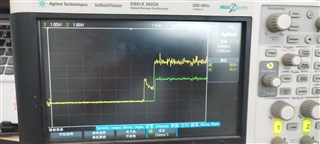Other Parts Discussed in Thread: TPS563200
Tool/software:
I am using TPS563200 to supply 1.9V and 3.3V power supplies such as IO to F28335 arch core power supply. The waveform of the power on is as follows: yellow is 3.3V, blue is 1.9V; sometimes the program can start normally, sometimes it cannot. Is it related to the power on sequence? Is the waveform abnormal? What other suggestions do you have regarding the issue of the program not starting properly? The same TPS563200, if not connected to F283353.3V output, is normal without the jitter shown in the figure;


